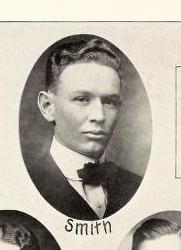Each year, the members of First Methodist work to create a distinctive atmosphere on the Sunday in May designated as Mother’s Day. Decorations, additional flowers, special treats from fresh fruit to chocolates adorn the corridors and worship areas. Guest speakers and artists frequently bring unique testimonies. All the ladies attending receive small gifts as they leave worship. Everyone attending enjoys the out of the ordinary atmosphere of celebration.

Smith followed a succession of middle-aged ministers who had come from other states and under whom the church had stagnated a bit. His youthful enthusiasm invigorated the church and quickly carried him into community leadership. He dropped the old church title of “Methodist Episcopal Church, South” and replaced it with the shorter and more dynamic title “First Methodist.”
The roots of the day extended much further into the past, however, another half-century back to the turbulent days just prior to the Civil War and held a special Methodist connection as well. In 1858, a young Appalachian homemaker named Ann Marie Reeves Jarvis began “Mothers Friendship Day” as an effort to improve sanitation. Part of her fervor to help others came from her faithful membership in her local Methodist church.
With the coming of the Civil War a few short years later, Jarvis shifted her efforts toward the care of wounded soldiers and better sanitary condition for both Union and Confederate armies. She was not alone in her work. Influential women like Julia Ward Howe undertook similar campaigns.
Ann Marie Reeves Jarvis continued her efforts until her death in 1905. Following her death, her daughter, Anna, dedicated her life to establishing Mother’s Day to “honor mothers, living and dead” and as a special memorial to her mother. She gained the financial backing from Philadelphia department store owner John Wanamaker and, in May 1908 the first official Mother’s Day celebration took place at her Methodist church in Grafton, West Virginia. That same day thousands of people attended a Mother’s Day event at one of Wanamaker’s Philadelphia stores.
Young Reverend Smith would remain in Midland for a second year. His next appointment was in Nashville, Tennessee. Smith would rise through the Methodist organization, earning an M. A. degree at Columbia and eventually earning several honorary Doctor of Divinity degrees. In 1944, he was elected to the Episcopacy of The Methodist Church and served as Bishop for Oklahoma and New Mexico.
Though his career eventually carried him far beyond the small church in Midland, Reverend W. Angie Smith and Bessie would always fondly remember their youthful days there and the special Mother’s Day heralding the arrival of Angie III.
- “Mother’s Day At Methodist Church, The Midland Reporter, May 19, 1922, p. 8.
- The Midland Reporter, October 28, 1921, p. 1.
- ”The History of Mother’s Day” http://www.theholidayspot.com/mothersday/history.htm#STvHTDy4XBAofzzF.99 accessed May 9, 2016.
- http://peacealliance.org/history-of-mothers-day-as-a-day-of-peace-julia-ward-howe/#sthash.T2nraEXf.dpuf accessed May 9, 2016.
- “Mother’s Day” http://www.history.com/topics/holidays/mothers-day accessed May 9, 2016.
- The Midland Reporter, May 26, 1922, p. 8.
